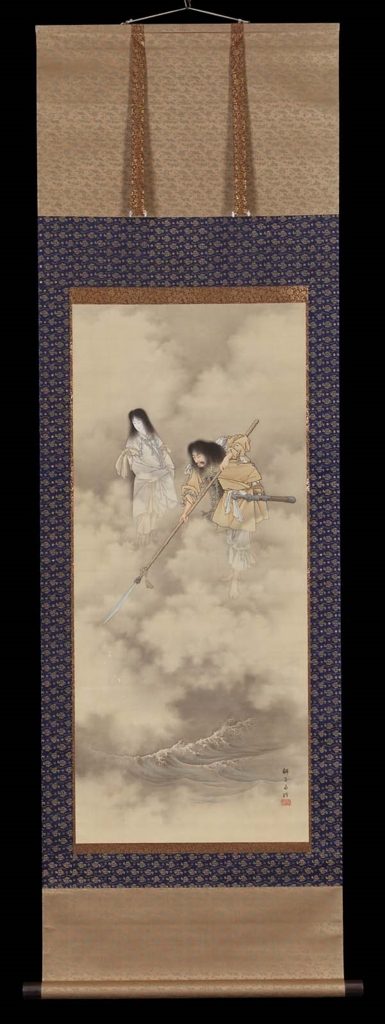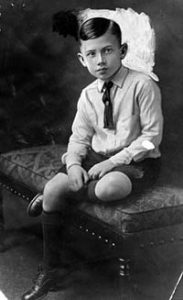The story of Izanagi and Izanami is the creation myth of the Shinto religion that is told in the Nihonshoki, Kojiki, and Kogoshui, which are “collections of oral myths” written during the eighth and ninth centuries C.E.1 The myth begins with “something light and transparent” rising up from a sea of “boundless, shapeless” chaos and becoming the Plain of High Heaven.2

Then the Three Creating Deities spring forth from the Plain: Ame-no-Minaka-Nushi-no-Mikoto, Takami-Musubi-no-Mikoto, and Kammi-Misubi-no-Mikoto.3 Meanwhile, the sea of chaos had become the earth, but the land floated “resembling oil” on the water. Then, the gods Umashi-Ashi-Kahibi-Hikoji-no-Mikoto and Ame-no-Tokotachi-no-Mikoto spring forth from the land. After this, many other gods were born until one day, a pair of gods named Izanagi and Izanami were given a spear decorated with jewels by the other gods and told to create solid land, as these gods did not have anything to do.3
Izanagi and Izanami then stood on Ama-no-hashidate, the “bridge or stairway of heaven.”5 They were initially confused as to how they were supposed to create solid land until Izanagi proposed that they stick the spear into the water and stir it around. Izanagi then stuck the spear into water, hit something, and noticed that the substance that dripped from the spear when he took it out became the island of Onogoro.6 Izanami and Izanagi then built a home on Onogoro and conducted a marriage ritual that involved them circling around a pillar, Izanami traveling in one direction and Izanagi traveling in the other direction. The first time they did this, Izanami was the first to greet Izanagi when they met.7 Despite Izanagi’s belief that Izanami should not have spoken first, they conceived a child.8
Unfortunately, their first child, the god Hiruko, was born deformed and boneless, so Izanagi and Izanami put Hiruko in a boat and abandoned him to the sea. Izanami then gave birth to the island of Awa, but the couple were still unhappy with their children, so they decided to ask the other gods what to do.9 The other gods told the couple that Izanagi was supposed to greet Izanami during their marriage ritual, not the other way around. Izanagi and Izanami then performed the marriage ritual correctly and from that point forward were pleased with their children, who included the “eight principal islands of Japan.”10
Izanami and Izanagi then gave birth to many other gods. Unfortunately, their happiness would not last. While Izanami was giving birth to the fire god Kagutsuchi, she suffered painful burns and, despite Izanagi’s attempts to save her life, died from her burns.11 Izanagi was devastated by his wife’s death and, in his rage, decapitated Kagutsuchi with his sword. Many deities were spawned from Kagutsuchi’s blood and corpse.12
Heartbroken and desperate to see his wife again, Izanagi decided to go down into Yomi-tsu-kuni, the underworld, and bring Izanami back to life. Unfortunately, Izanami was unable to leave the underworld as she had already eaten its food.13 Izanami decided to appeal to the gods of the underworld to allow her to return to life, but she made Izanagi promise to wait for her and told him not to try to see her or “look inside the castle” of the underworld until she came back. Izanagi agreed, but he quickly became anxious to see Izanami. Eventually the wait proved too much for Izanagi, so he lit part of a comb that he had with him on fire and attempted to see Izanami.14 However, he soon found out firsthand why Izanami did not want him to see her. Izanami’s body was rotting away and “eight Thunder-Deities” were “dwelling there” within her body. The very sight of it caused Izanagi to flee in fear, which along with the fact that he broke his promise, angered Izanami.15 She swore to make him “suffer for his perfidy” and ordered “an army of female demons to chase him out of the underworld.”16 During Izanagi’s escape, he threw his stick down, which created the two gods of the road, and pushed a boulder into the entrance of the underworld so that he could safely get away.17 Afterwards, while bathing in the river Woto in order to clean “the impurities of the underworld” off of him, multiple other gods were created when he took off his clothes and washed various parts of his body. This is why followers of Shintoism purify themselves before entering shrines.17 Izanami and Izanagi are commemorated in the “wedded rocks of Meotoiwa.” The “wedded rocks of Meotoiwa” are a pair of rocks representing Izanagi and Izanami that are linked by a “sacred long rope” representing their marriage.17
- Mark Cartwright, “Izanami and Izanagi,” Ancient History Encyclopedia, last modified December 06, 2012, http://www.ancient.eu /Izanami_and_Izanagi/. ↵
- Genji Shibukawa, “Japanese Creation Myth,” in Reading about the World, Volume 1, trans. Yachiro Isobe, n.d. ↵
- Genji Shibukawa, “Japanese Creation Myth.” ↵
- Genji Shibukawa, “Japanese Creation Myth.” ↵
- Mark Cartwright, “Izanami and Izanagi,” Ancient History Encyclopedia. ↵
- Mark Cartwright, “Izanami and Izanagi,” Ancient History Encyclopedia. ↵
- Mark Cartwright, “Izanami and Izanagi,” Ancient History Encyclopedia. ↵
- Genji Shibukawa, “Japanese Creation Myth.” ↵
- Mark Cartwright, “Izanami and Izanagi,” Ancient History Encyclopedia. ↵
- Mark Cartwright, “Izanami and Izanagi,” Ancient History Encyclopedia. ↵
- Genji Shibukawa, “Japanese Creation Myth.” ↵
- Genji Shibukawa, “Japanese Creation Myth.” ↵
- Mark Cartwright, “Izanami and Izanagi,” Ancient History Encyclopedia. ↵
- Genji Shibukawa, “Japanese Creation Myth.” ↵
- Genji Shibukawa, “Japanese Creation Myth.” ↵
- Genji Shibukawa, “Japanese Creation Myth.” ↵
- Mark Cartwright, “Izanami and Izanagi,” Ancient History Encyclopedia. ↵
- Mark Cartwright, “Izanami and Izanagi,” Ancient History Encyclopedia. ↵
- Mark Cartwright, “Izanami and Izanagi,” Ancient History Encyclopedia. ↵



29 comments
Sebastian Carnero
Interesting article. I can’t stop thinking about how Izanagi could have killed Kagutsuchi, his own son. It is also worth noticing that Gods were created from other events apart of Izanagi and Izanami’s ritual, removing clothes, blood and dropping a pole. I also find curious the idea that Gods have feelings and even more feelings as intense as the ones shown in this story. It was a really beautiful story, how the creation of the Islands was interpreted. It really shows how much respect and consideration the culture has for its deities.
Honoka Sasahara
I did not know the detail of the Izanami and Izanagi’s story before reading this article. Although I am from Japan, I didn’t learn it in any schools or books at home. I felt this story has typical features of Japanese old story such as visiting underworld or putting someone in a boat and abandoning him. Indeed, I am familiar with the tradition in this kind of story that “If you eat something in the world you visit, you can’t go back from the world”.
Emily Jensen
Until reading this article I had never heard of this ‘oral myth’ of creation. How interesting it is that this creation story is so similar to that of Christianity, something arising from nothing, and yet the rest of the religion can be so unique. I enjoyed reading this article because the author did a fantastic job at explaining the story to an audience that has no prior knowledge of the subject.
Samuel Ruiz
Very good article, Trey. While I found the entire article to be interesting, I was stuck on one detail that began the story of the myth. I just cannot wrap my mind around how the “Plain of High Heaven” and the earth just came from the sea of chaos. Additionally, I just cannot imagine how the sea of chaos existed and then created what we know today. Just some of my inside thinking, but still a great article!
Tyler Thompson
The Japanese creation story was very interesting, and the author did a good job describing these series of events. I thought that it was crazy in the story that so many gods and goddesses were created through many different situations. Although Izanami was very upset with her Izangai due to what happened in the underworld, it is still nice that there is still a visual representation of their marriage in Japan.
Crystalrose Quintero
It was so interesting to read creation of the shinto religion. In comparing our religion its interesting because catholicism doesn’t really have a myth creation story. It was also an interesting story to think that the brith of many gods came from two key characters. The article was an interesting read and was written in a way that was more approachable. The creation myth of religion today is used in their religion and that was such a beautiful experience.
Mario Sosa
I would imagine it to be confusing to explain the names of the Three Creating Deities to foreigners. I know virtually nothing about the Shinto religion, so it was really great to read about two of its most prominent figures. The story between Izanami and Izanagi was very fascinating, but the tale seems to leave a lot of loose ends, such as what became of Hiruko and the other children Izanami had, as well as how and why new gods were being created when Izanagi was running from the underworld and washing himself. Despite the lingering questions, I enjoyed reading the article; good job!
Oceane Roux
Thank you for this article! I didn’t know anything about the Tale of Izanami and Izanagi before reading this article. I think learning about other’s religions and rituals is very interesting. I enjoyed the story of these two Gods. Their ethic is questionable, but it touches on the struggles that a human could face: not loving his children and not respecting the marriage ritual. Mythology is really interesting!
Alejandro Garza
Never knew exactly what the Japanese creation myth was despite being familiar with its pantheon of gods/goddesses so this was a very interesting read for me. It’s interesting to see that the gods created the land itself and the story of Izanami’s death and Izanagi visiting her in the underworld and eventually being run out by Izanami herself along with several demons she sent after him.
Cameron Mays
This article was well-researched and because it is not something heavily talked about; you probably have some sort of passion in this type of stuff, which is great. On the flip side, the structure, wording, and grammar seemed a little off, which led to me being pretty lost as the story went on. To fix this, I feel, you could have just used the english names for somethings and wrote a little more fluid.